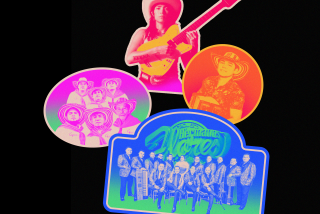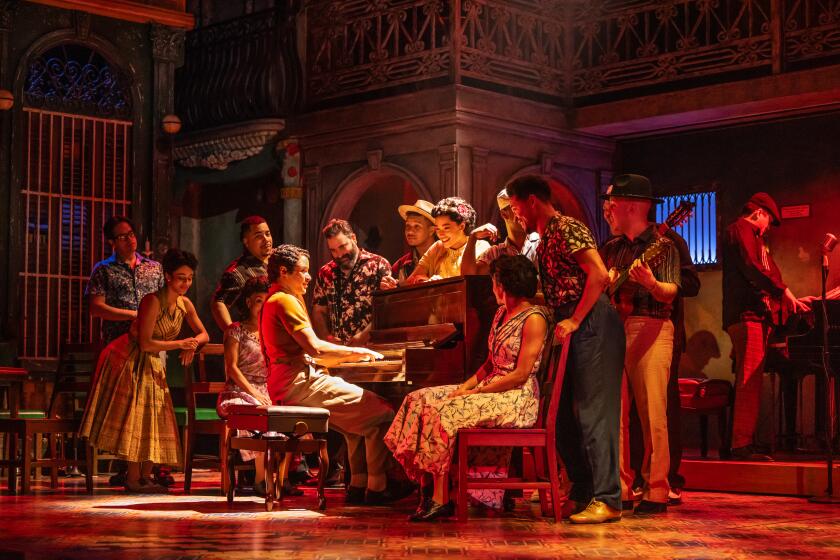A closer look at Ayllon’s magic
- Share via
There’s always a sense of occasion when the music of marginalized people is presented in the prestigious venues of mainstream society, like salsa at Carnegie Hall or mariachis at the Hollywood Bowl. It’s far from novel, but it still elevates expectations, as if by crossing some symbolic social barrier the music of the dispossessed will not only gain status but somehow sound better.
Such was the case for Friday’s concert at Walt Disney Concert Hall by singer Eva Ayllon, the world’s leading exponent of Afro-Peruvian music, a rousing and romantic urban genre that not too long ago was marginalized even in its native country. Unfortunately, in this case the gleaming showcase served to muddle rather than enlighten the music, at least from some vantage points in downtown’s landmark auditorium.
From the balcony, Ayllon’s booming 14-piece band sounded cold, distant and hollow rather than hallowed. The ears could hear every instrument but somehow the brain wasn’t able to perceive them in unison, which makes for headaches.
Obviously, the symphony hall wasn’t made for bottom-heavy, percussive music normally heard in nightclubs. The louder and stronger the music got, so did the headache. The only relief came at times when the band fell silent and Ayllon dropped her microphone, finishing a line a cappella. It’s as if the acoustic heavens cracked open briefly, letting her smoky and sensual voice resonate with its pure and natural beauty, for which the space seemed exquisitely designed.
The sound was much better for people in the front rows, as I discovered after persuading a gang of dutiful ushers to let me move. But while waiting for their manager and a verdict, I had to watch a small lobby monitor so as not to miss Ayllon’s climactic performance of “Toro Mata,” the Afro-Peruvian classic that the late Celia Cruz popularized in a salsa version. Once I was seated near the stage for the song’s finale, her rendition sounded unusually robust and dynamic.
This is how Afro-Peruvian music is meant to be enjoyed -- at eye level with the performers. The style has its roots in coastal communities of former African slaves who created distinctive instruments from the implements of labor, such as the cajon, or crate, which is now the staple of Peruvian percussion and an iconic symbol of its culture.
Ayllon’s band, beefed up with guest instrumentalists, was missing her veteran cajonero, the affable and in-demand Gigio Parodi, who had conflicting commitments. But two other regular percussionists were on hand, Rony and Marco Campos of the song-and-dance ensemble Peru Negro, reinforced by the flashy multi-instrumentalist Ricardo “Tiki” Pasillas, a Mexican American who has toured with salsa star Marc Anthony. Along with Venezuelan pianist-arranger Allan Phillips and the gray-haired Afro-Mexican bassist Abraham Laboriel, as nimble on his feet as on the strings, the ensemble proved you don’t have to be Peruvian to master the music’s unique feeling and cadence.
Ayllon, 42, is in her prime, playful and animated on stage. Vocally, you can put Eva in a class with Della, Ella and Celia. She has the smoky soulfulness of Della Reese, the technical command of Ella Fitzgerald and the rhythmic mastery of Celia Cruz.
Friday’s 90-minute set was essentially the same as the singer’s 2006 performance at the Ford Amphitheatre, available on DVD as “Eva Ayllon: Live From Hollywood.” She always balances the festive and lusty Afro-Peruvian rhythms, such as lando and festejo, with the achingly romantic vals criollo. The earthy, bohemian adaptation of the classic waltz is enormously popular in Lima, where it’s heard in nightclubs called penas, clubs that started as neighborhood gatherings of musicians also featuring comida criolla, typical food as tasty as the music.
Anybody who’s been there and experienced this alluring culture up close can appreciate the nostalgia expressed at one point by Ayllon, who left her homeland for career reasons and now lives in New Jersey.
“It has now been three years, two months and two days,” she says, marking the time elapsed in her self-imposed exile. “My body may be here, but my mind and my heart will always be there.”
--
More to Read
The biggest entertainment stories
Get our big stories about Hollywood, film, television, music, arts, culture and more right in your inbox as soon as they publish.
You may occasionally receive promotional content from the Los Angeles Times.










